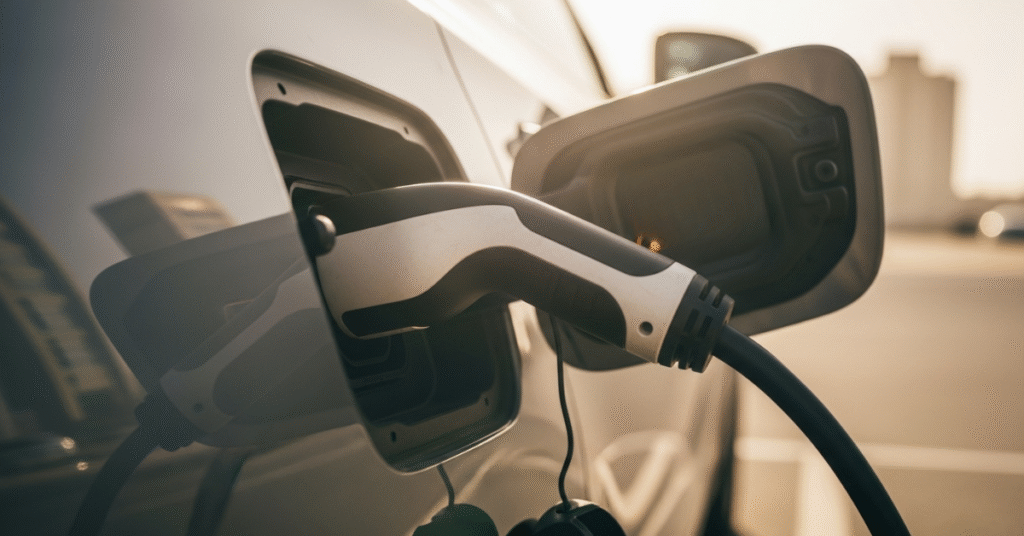Hybrid & EV Battery Maintenance in Dubai’s Hot Climate: Complete Care Guide
Dubai’s scorching summers put extraordinary stress on your hybrid or electric vehicle’s battery systems. When temperatures soar above 43°C and your parked car’s interior reaches 70°C, both your main traction battery and auxiliary 12V battery face challenges most drivers don’t even know exist.

If you’re searching for the best car batteries in Dubai for your hybrid or EV, understanding how heat affects these complex systems is your first step toward protecting your investment. Unlike conventional vehicles with a single battery, hybrids and EVs rely on dual battery systems that each require specific care in our extreme climate.
This guide cuts through the confusion with verified facts about maintaining both battery types, recognizing failure signs before they strand you in Mall of the Emirates parking, and keeping your eco-friendly vehicle running efficiently through Dubai’s brutal summer months.
Understanding Your Hybrid & EV Battery Systems
Two Batteries, Two Different Jobs
Your hybrid or EV doesn’t just have one battery – it has two completely separate systems working together.
The high-voltage traction battery powers your electric motor and moves the car. This is the large battery pack you hear about in EV range discussions. In hybrids, it works alongside your petrol engine. In full EVs, it’s your only power source.
The 12-volt auxiliary battery powers your car’s computer systems, lighting, locks, and infotainment. Think of it as the “brain battery” that enables everything to boot up. Without it, even a fully charged traction battery won’t help – your car simply won’t start.
Here’s what catches Dubai drivers off guard: the auxiliary battery enables the vehicle to enter READY mode. No 12V power means no driving, regardless of your main battery’s charge level.
Why This Matters in Dubai
Both batteries hate heat, but they suffer differently in our climate.
Your traction battery has sophisticated thermal management with liquid cooling systems and sensors. Manufacturers like Tesla, BYD, and Kia engineered these specifically for hot climates.
Your auxiliary battery typically lasts 3-5 years but may degrade faster in extreme temperatures. In Dubai’s conditions, that timeframe shrinks significantly. Yet most drivers never think about this small but critical component until it fails.
How Dubai’s Extreme Heat Affects Hybrid & EV Batteries
The Temperature Reality
Let’s talk numbers. Dubai’s summer from June to August exhibits extremely high temperatures, peaking at an average of 39.4°C in July. But that’s just the outdoor air temperature.
In July and August, temperatures in Dubai exceed 43°C with extreme heat and humidity. The highest temperature recorded in Dubai is 50.1°C, reached in July 2023.
And here’s the real problem: the temperature inside a parked car can exceed 70°C due to heat buildup inside the cabin and body. Your batteries sit in this environment every time you park at Dubai Mall, Ibn Battuta Mall, or along Sheikh Zayed Road.
Recent heatwaves made conditions even more severe. Between 10 June and 29 June 2024, temperatures reached 46°C in the city and 49.4°C in the suburbs. On 17 July 2024, Dubai’s ‘feel like’ temperature rose to 62°C.
What Heat Does to Battery Chemistry
Most EVs use lithium-ion batteries that perform best within a moderate temperature range of about 15°C to 35°C. Dubai spends four months far above that optimal range.
As lead acid batteries absorb high heat, chemical activity in the battery accelerates, reducing service life at a rate of 50% for every 18°F (10°C) increase from 77°F (25°C). This scientific reality applies to both your traction and auxiliary batteries.
In practical terms: if a battery has a design life of six years at 77°F, and the battery spent its life at 95°F, then its delivered service life would be three years.
For Dubai drivers parking in Business Bay or Marina, this means your batteries age twice as fast as they would in temperate climates.
The Four Heat-Related Threats
Temporary range reduction. Exposure to very high temperatures causes a temporary reduction in battery efficiency, leading to a shorter driving range per charge. Your morning commute to Al Quoz Industrial Area might show a full range, but after sitting in JLT parking all day, you’ll notice the drop.
Accelerated chemical degradation. Hotter temperatures cause the electrolytes inside the modules of the hybrid battery pack to evaporate over time, degrading the battery’s ability to hold a charge in the long term. This permanent damage accumulates with each Dubai summer.
Slower charging speeds. High temperatures cause slower charging speeds, especially during fast charging, to prevent overheating. That quick charge you’re counting on at City Walk might take longer than expected on a July afternoon.
Thermal runaway risk. While rare, extreme cases can experience severe thermal issues known as thermal runaway. Modern thermal management systems prevent this, but only if they’re properly maintained.
Caring for Your Traction Battery in Dubai Summer
Thermal Management Systems: Your Battery’s Air Conditioning
EV manufacturers incorporate advanced thermal management systems into their vehicles including liquid cooling systems integrated within the battery pack, heat pumps capable of heating or cooling, and smart sensors and software.
Think of these as your battery’s dedicated climate control. From coolant flow checks to sensor calibration and cooling unit repairs, proper maintenance ensures your battery stays healthy, efficient, and protected from overheating.
Not all vehicles have equal protection. Premium models typically have active liquid cooling or heat pumps, while budget or older EVs may rely on passive air-cooling, which is less effective in high temperatures.
If you’re considering purchasing a hybrid or EV in Dubai, check for advanced battery thermal management systems that perform reliably in hot climates.
Strategic Parking Saves Battery Life
Where you park matters more than you think.
Parking in shaded areas reduces the amount of solar radiation absorbed by the car and helps keep interior temperatures relatively low, preserving battery cell integrity.
Every Dubai driver knows the desperate hunt for shaded parking at the Mall of the Emirates or Festival City. That effort isn’t just about comfort – it’s about battery preservation.
Covered building parking and underground garages protect the battery more effectively from high temperatures than open lots because cooler ambient temperature reduces thermal stress on cells.
If you work in Marina or Downtown Dubai, paying for covered parking isn’t a luxury – it’s battery maintenance. Your vehicle’s cooling system won’t need to work as hard, and your battery stays within optimal temperature ranges.
When shaded parking isn’t available, drivers should park the car so that direct sunlight exposure is minimized. Facing your car away from the afternoon sun on Sheikh Zayed Road makes a measurable difference.
Smart Charging Timing
When you charge matters as much as where you park.
Charging the vehicle during peak heat significantly accelerates battery cell degradation, so it’s best to begin charging in the early morning before sunrise or after sunset when ambient temperatures drop noticeably.
Dubai’s electricity rates support this strategy too – off-peak charging saves money while protecting your battery. Set your EV to charge overnight and wake up to a full battery that hasn’t been stressed by midday heat.
Charge to around 80% during the summer months to avoid overheating the battery, as overcharging in high temperatures can reduce battery life. Your car’s battery management system helps, but you can optimize further by adjusting your charge limit.
If you’re using DC fast charging at a station in Arabian Ranches or Mirdif, avoid using fast charging immediately after long drives as the battery needs a cooling period before a full charge.
Coolant System Maintenance
Your battery’s cooling system needs attention just like your car’s engine cooling system once did.
EVs have cooling systems that prevent overheating, so regularly check coolant levels and refill if necessary, and ensure vents and cooling fans are clear of dust and debris.
Dubai’s dust and sandstorms clog these systems faster than you’d expect. A quick visual check every few weeks prevents bigger problems. If you hear your cooling fan running constantly after driving in Al Quoz or Industrial Area No. 1, it’s time for inspection.
Professional services flush and refill coolant systems to maintain proper thermal regulation, verify thermal sensor accuracy, and inspect pumps, valves, and cooling modules.
Optimal Battery Charge Levels
Keep your battery charge level between 20% and 80% to reduce strain, avoiding full charges or deep discharges, which can impact lifespan.
This “sweet spot” strategy becomes even more critical in Dubai’s heat. The battery management system works less aggressively when you’re not pushing the extremes, generating less internal heat in the process.
For daily driving around Dubai – commuting from Arabian Ranches to Media City or running errands in Jumeirah – you rarely need a full charge anyway. Save the 100% charges for those weekend road trips to Abu Dhabi or Al Ain.
If your car will sit unused for extended periods (common during travel seasons), leaving it between 20-80% charge is better for longevity than leaving it fully charged or depleted.
Maintaining Your Auxiliary (12V) Battery: The Overlooked Critical Component
Why Auxiliary Batteries Fail Faster in the UAE
Most hybrid and EV owners focus entirely on the big traction battery and forget about the small 12V battery hiding somewhere in their vehicle. This oversight causes more roadside breakdowns than traction battery issues.
Hybrid 12V batteries are designed for frequent partial discharges and recharge cycles, using enhanced lead-acid or AGM technology to handle energy recovery systems. They’re built differently from regular car batteries, but they’re still vulnerable to heat.
Even under hot climate conditions, AGM batteries were found to be highly durable and superior to flooded batteries, but that doesn’t mean they’re indestructible.
The cruel reality: for every 10°C average temperature higher than 20°C, you lose about 50% of your lifespan. In Dubai’s summer, where ambient temperatures consistently exceed 40°C, your auxiliary battery is aging at an accelerated rate.
Recognizing Auxiliary Battery Failure Signs
Common symptoms include dashboard warning lights, slow engine cranking, flickering headlights, malfunctioning electronics, and failure to start the hybrid system.
Here’s what this looks like in real Dubai scenarios:
You press the start button in your Lexus hybrid after a day of shopping at Dubai Mall, and nothing happens. No dashboard lights, no chime, completely dead. That’s auxiliary battery failure.
Or you notice your hybrid system warning light appearing intermittently during your morning commute on Al Khail Road. A weak or failing 12V battery can trigger the hybrid system warning and disable READY mode, causing the engine to run continuously.
Even stranger: if your hybrid turns on but won’t move, think hybrid battery, but if it won’t turn on at all, think 12V battery. Most drivers assume the opposite.
Many hybrid vehicle owners report sudden 12V failures, especially when the car sits for long stretches. If you’re traveling internationally and leaving your car at Dubai Airport parking for two weeks, this becomes a real risk.
Best Battery Types for Dubai Climate
Not all 12V batteries handle heat equally.
Using an AGM battery is best for those living in climates consistently above 80 degrees Fahrenheit, as exposure to high temperatures causes car batteries to have increased electrolyte evaporation.
Dubai easily qualifies. Our summer temperatures don’t just exceed 80°F – they often exceed 110°F.
Since AGM batteries have the plates encased, the effects of heat, including corrosion buildup and sulfation, are minimized. The sealed construction prevents the electrolyte evaporation that kills standard flooded batteries in our climate.
The cost difference is real but worthwhile. Initially, an AGM battery will cost 40 to 100% more than a regular lead battery. But a well-maintained AGM can last up to 7 years, while flooded batteries typically last around 3-5 years.
For a Dubai-based hybrid or EV owner, that extended lifespan in extreme heat makes AGM batteries the smart investment.
Replacement Timing and Testing
Don’t wait for complete failure. If the 12V battery voltage drops below 11.8 volts, the system may fail to operate, preventing the engine from starting and entering ready mode.
Professional testing reveals problems before they strand you. A healthy 12V battery should measure between 12.6V and 12.8V after sitting for several hours without a load, and below 12.4V suggests partial discharge.
It’s recommended to replace the 12-volt battery with one specifically designed for hybrid applications. Standard batteries won’t handle the unique demands of your hybrid’s electrical system.
Regular voltage checks become especially important before Dubai’s summer. A battery showing 12.5V in April might fail by July when temperatures peak.
Short Trip Challenges
Here’s something most hybrid owners don’t realize: when a hybrid is in electric mode, the 12V battery isn’t charging – the petrol engine needs to run for some time to charge the 12V battery.
For Dubai residents making short trips – driving from JLT to Marina Mall, or from Business Bay to Downtown – your engine might stay off entirely in EV mode. This pattern slowly drains your auxiliary battery.
Short trips, electronic accessories, and even parasitic drains from onboard systems can leave you stranded. Drive at least 20 minutes weekly to keep the 12V charged.
If your hybrid lifestyle involves mostly short urban trips around Deira or Bur Dubai, schedule longer highway drives periodically to fully recharge that auxiliary battery.
Professional Maintenance & Service in Dubai
When to Seek Professional Help
Some battery care you can handle yourself. Other situations demand professional expertise.
Seek professional service when:
- Dashboard warning lights appear related to battery or hybrid systems
- You notice a reduced range, and parking strategies don’t improve
- Your cooling fan runs constantly, which reduces the risk of thermal runaway or battery derating during hot weather
- Your car won’t enter READY mode even with an apparent charge
- You hear the hybrid fan running constantly, which is a clear sign you should consider inspection
Diagnostic Testing Matters
Use proper diagnostic tools, including OBD II scanners, to read battery health codes and voltages. Professional shops have equipment that goes far beyond basic voltage meters.
Conductance testing must be used to test an AGM battery, and accurate test results can only be obtained using lead adapters since steel bolts will disrupt the conductance frequencies.
This specialized testing reveals battery health that voltage alone can’t show. A battery might measure 12.6V but still fail under load due to internal degradation.
Seasonal Maintenance Calendar for Dubai Drivers
Pre-Summer Preparation (April-May)
Before temperatures soar, get ahead of problems.
Battery health inspection. Have both traction and auxiliary batteries tested. Schedule regular hybrid battery inspections, especially before and during the hottest months, as early detection of potential issues can prevent more serious damage.
Cooling system service. Regularly check coolant levels and ensure vents and cooling fans are clear of dust and debris. Spring is ideal for this service before the summer workload begins.
Auxiliary battery voltage check. If your 12V battery tests below 12.6V, consider replacement before summer stress finishes it off.
Review parking options. Scout covered parking near your office in DIFC or Business Bay. The monthly cost pays for itself in extended battery life.
Peak Summer Care (June-August)
When temperatures exceed 43°C, your batteries need maximum protection.
Daily parking discipline. Always park in shaded or covered areas such as garages, under trees, or sunshades to minimize direct sun exposure. No exceptions during these months.
Night charging only. Avoid charging during peak heat hours – nighttime charging is preferable when temperatures are cooler. Set your charge timers for after 10 PM.
Monitor range carefully. Note any significant drops in efficiency. A sudden 20% range reduction might indicate cooling system problems rather than battery degradation.
Keep it moving. Drive at least 20 minutes weekly to keep the 12V charged, especially if you’re mainly making short trips in the city.
Weekly visual checks. Look at your traction battery cooling vents for dust buildup. Keep the hybrid fan clean and ensure the area is free of debris like pet hair and dust, as a clogged fan can lead to overheating.
Post-Summer Assessment (September-October)
When temperatures finally drop below 40°C, assess summer’s impact.
Comprehensive battery health test. Both batteries endured months of stress. Professional testing reveals how they fared and predicts remaining lifespan.
Cooling system inspection. Ensure all components function properly through the heat. Replace any damaged sensors or worn pumps before next summer.
Range baseline. Establish your normal range in cooler weather. This becomes your comparison point for detecting degradation.
Year-Round Best Practices
Regardless of the season, certain habits protect your investment.
Regularly service your vehicle’s cooling system to ensure it operates correctly. Don’t skip scheduled maintenance intervals.
Use manufacturer-recommended charging stations across Dubai for a safe, stable power supply. Questionable public chargers can damage your battery.
Many manufacturers release software updates that improve battery efficiency and performance. Keep your vehicle’s systems current.
Monitor tire pressure frequently since heat causes tire pressure to increase, affecting driving stability and efficiency. Proper tire pressure reduces the load on your battery system.
Emergency Battery Care Tips
If Your Auxiliary Battery Dies
Although there are exceptions, many hybrids do not use the 12-volt auxiliary battery for starting the engine, but it does enable READY mode. You can jumpstart the 12V system just like a conventional car.
Jumpstart safety for hybrids/EVs:
- Use standard jumper cables connected to the 12V system only
- Never attempt to jump the high-voltage traction battery
- The auxiliary battery can be installed almost anywhere in the vehicle – common locations include under the hood, in the trunk, or under seats
- Check your owner’s manual for exact jump point locations
Most hybrid and EV manufacturers provide specific jump terminals under the hood even if the actual battery sits elsewhere. Look for a red positive terminal marked with a battery symbol.
When Stranded on Dubai Roads
If your hybrid or EV won’t start while you’re parked on Sheikh Zayed Road, Al Khail Road, or anywhere in the city:
Call for professional mobile service. Emergency battery services reach you anywhere in Dubai with the equipment and batteries needed for on-site replacement.
Don’t attempt DIY fixes in extreme heat. Working under the hood when it’s 48°C outside risks heatstroke. Leave it to professionals with proper equipment and experience.
Move to shaded areas if possible. If you can get the car started briefly, move to covered parking immediately. This prevents further heat stress while you arrange proper service.
Stay hydrated and cool. Don’t wait in a hot car. Dubai’s heat can become dangerous quickly. Wait in an air-conditioned nearby building if possible.
FAQ: Your Hybrid & EV Battery Questions Answered
How long do hybrid batteries last in Dubai’s climate?
With proper care, the right vehicle choice, and maintenance, EV batteries in the Gulf and Middle East can last 8 to 12 years while retaining about 80% or more of their original capacity. Most manufacturers back this up with warranties of 8 years or a specified mileage limit like 160,000 km.
However, this assumes proper maintenance. Neglecting cooling systems, consistently parking in direct sun, and ignoring warning signs will reduce this lifespan significantly.
Are AGM batteries worth the extra cost for auxiliary battery replacement?
Absolutely. AGM batteries cost 40 to 100% more but perform better in climates consistently above 80 degrees Fahrenheit. In Dubai’s reality, where we regularly exceed 100°F, that performance advantage directly translates to longer life and fewer roadside emergencies.
Can I use a regular car battery in my hybrid?
No. The replacement auxiliary battery must be of approved OEM design and construction. Hybrid auxiliary batteries handle different charge/discharge cycles than conventional car batteries. Using the wrong type can cause system failures and void warranties.
Does frequent fast charging damage my battery in hot weather?
Frequent rapid charging can reduce long-term battery health, and this effect amplifies in heat. Use DC fast charging when necessary, but rely on slower Level 2 charging overnight for daily needs. Your battery’s thermal management system works harder during fast charging, generating additional heat in already extreme conditions.
Should I worry about thermal runaway in Dubai?
Rare cases of severe thermal issues known as thermal runaway exist, but modern thermal management systems prevent this through automatic measures that reduce or halt charging if temperatures become unsafe. With proper maintenance, the risk remains extremely low even in Dubai’s heat.
Why does my hybrid’s 12V battery die faster than my old conventional car’s battery?
When the hybrid is in electric mode, the 12V battery isn’t charging – the petrol engine needs to run to charge it. Combined with the reality that at every 10°C above 20°C you lose about 50% of your lifespan, Dubai-based hybrids face a perfect storm of factors that drain auxiliary batteries faster.
Can I leave my EV or hybrid parked at the airport for two weeks during the summer?
Yes, but with precautions. Leave the battery charge between 40-60%. Ensure your auxiliary battery is in good health before departure. Many hybrid vehicle owners report sudden 12V failures, especially when the car sits for long stretches. If possible, have someone start the car and let it run for 20 minutes midway through your trip.
What’s the single most important thing I can do to protect my batteries in Dubai?
Covered building parking and underground garages protect batteries more effectively than anything else because cooler ambient temperature reduces thermal stress on cells. If you can only change one habit, make it parking location. The difference between 70°C and 30°C ambient temperature dramatically impacts battery lifespan.
Conclusion: Protecting Your Investment in Dubai’s Climate
Dubai’s extreme heat challenges even the most advanced hybrid and EV battery technology. But with the right knowledge and consistent habits, your vehicle’s batteries – both the high-voltage traction battery and the often-forgotten auxiliary battery – can deliver their full designed lifespan despite our harsh conditions.
The key strategies remain constant: prioritize shaded parking wherever you are in Dubai, charge during cooler evening hours, maintain thermal management systems professionally, and don’t ignore early warning signs of auxiliary battery problems.
Modern hybrids and EVs represent the future of transportation in the UAE, supported by expanding infrastructure and government initiatives. They work brilliantly here – when properly cared for.
My Experience with Battery Zone UAE
Last August, my hybrid RAV4 refused to start after parking at Dubai Festival City Mall. The 12V battery had died without warning – nearly four years old and never tested.
Battery Zone UAE’s mobile service arrived within 45 minutes, diagnosed the problem, and replaced it with a proper AGM battery on the spot.
The technician explained why AGM batteries handle our heat better and recommended a testing schedule. Since then, I’ve relied on them twice more for preventive checks.
If you own a hybrid or EV in Dubai, having a reliable mobile battery service like Battery Zone UAE in your contacts saves you from being stranded in 48°C heat.





